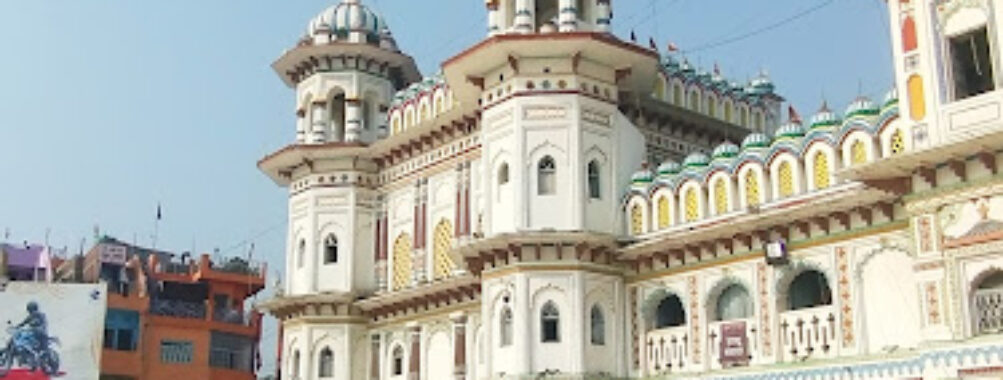
Janaki Temple
Table of Contents
Description
If you’re the kind of traveler who digs a mix of history, spirituality, and a splash of architectural flair, the Janaki Temple might just steal your heart. This isn’t your run-of-the-mill temple; it’s a grand Mughal-style Hindu temple dedicated to the goddess Sita, a figure who’s deeply revered in Indian mythology. What really sets this place apart is the stunning golden statue of Sita that sits inside — it’s not just a religious symbol but a work of art that glimmers with an almost hypnotic charm under the temple’s soft lighting.
The temple’s design is a fascinating blend of cultural influences, with intricate carvings and arches that echo the grandeur of Mughal architecture but still hold a distinctly Hindu spiritual vibe. It’s like walking through a page of history while feeling the pulse of devotion all around you. The temple is a pilgrimage spot, so you’ll find a steady flow of devotees, but it never feels overwhelmingly crowded — there’s a calmness to the place that invites quiet reflection.
One thing I noticed, and I think you’ll appreciate this too, is the way the temple balances tradition with accessibility. It’s one of those rare spots where the entrance and parking are wheelchair accessible, which honestly, is a breath of fresh air when you think about how many historic places can be a pain to navigate. Plus, the presence of clean restrooms and free parking makes it super traveler-friendly — no hidden hassles here.
It’s also worth mentioning that the temple is women-owned, which adds a layer of inspiring modernity to this ancient place. You get this subtle but powerful vibe of empowerment blended with centuries-old devotion. It’s like the past and present having a meaningful conversation.
Key Features
- Elaborate Mughal-style architecture with detailed carvings and arches
- Home to a captivating golden statue of goddess Sita, a rare sight in temples
- Recognized pilgrimage site attracting devotees and curious travelers alike
- Wheelchair accessible entrance and parking lot, ensuring ease of access for all
- Free parking available on-site, a big plus for those driving in
- Clean and well-maintained restrooms within the temple complex
- Women-owned establishment, adding a unique touch of empowerment
- Onsite services available, making your visit more convenient and immersive
Best Time to Visit
Now, if you want to catch the Janaki Temple at its absolute best, timing is everything. The cooler months, from October through March, are ideal. The weather is much kinder then — not too hot, not too humid — which makes wandering around the temple complex a lot more enjoyable. Plus, this period coincides with several Hindu festivals, so you might get lucky and witness some vibrant celebrations that add layers of color and energy to your visit.
That said, if you’re not into crowds, avoid the peak festival days. They can get pretty packed, and while the energy is electric, it might be a bit overwhelming if you’re seeking a peaceful experience. Early mornings during the off-season can offer a more serene vibe, with soft sunlight filtering through the temple’s arches and fewer visitors around.
How to Get There
Getting to Janaki Temple is easier than you might think, especially if you’re coming from nearby cities or towns. Most travelers find it convenient to reach by road — there’s a free parking lot right at the temple, so having your own wheels or hiring a taxi is a solid choice. If you’re coming from farther away, the nearest major railway station or airport will have local transport options like buses or taxis that can get you there without much fuss.
For those who enjoy a bit of adventure, the drive itself offers glimpses of the surrounding landscapes and local life, which can be quite charming. Just a heads-up: the roads near the temple are generally in good shape, but during the monsoon season, things can get a bit slippery, so plan accordingly.
Tips for Visiting
Alright, here’s where I get a little personal — when I visited Janaki Temple a couple of years ago, I learned a few things the hard way, and I’m here to save you from the same little hiccups.
- Dress modestly: It’s a place of worship, so keep your attire respectful and comfortable. Light fabrics work best, especially if you’re visiting in warmer months.
- Carry some cash: While there aren’t many shops inside, small donations or buying local offerings might require cash. Don’t rely solely on cards or digital pay.
- Respect the rituals: If you’re lucky enough to catch a prayer or aarti, try to observe quietly. It’s a beautiful experience and gives you a peek into the local spiritual culture.
- Use the restroom before you enter: Even though there are restrooms onsite, they can get busy during peak hours.
- Go early: To avoid crowds and enjoy the peaceful atmosphere, try to reach right when it opens.
- Photography: Be mindful about photography — some areas might restrict it, especially around the statue. Always ask if you’re unsure.
- Stay hydrated: Especially if you’re visiting during the hotter months, carry a bottle of water. The temple grounds are spacious and you’ll be doing a fair bit of walking.
- Chat with locals: Don’t hesitate to strike up a conversation with the temple staff or devotees. They often share fascinating stories and insights you won’t find in guidebooks.
Visiting Janaki Temple isn’t just about ticking off a landmark on your travel list. It’s about soaking in a piece of living history, feeling the devotion that’s been alive for centuries, and maybe, just maybe, catching a glimpse of something golden that stays with you long after you leave.
Location
Places to Stay Near Janaki Temple
Find and Book a Tour
Explore More Travel Guides
No reviews found! Be the first to review!